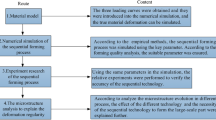Abstract
In this paper, a kind of flow-solid sequence coupling technology for forming large aluminum alloy automotive covering parts was presented. Firstly, the numerical simulation of hydraulic bulging process was carried out. Then, the springback analysis and mold surface compensation for the simulation results were implemented. The hydraulic bulging test was made by using the optimized compensation surfaces of mold, and the hydraulic bulging parts with relatively accurate shape were obtained. The accuracy of the numerical simulation results was verified by comparing the experimental values and simulation values of the 3D deviation on the same measurement paths; then, in order to form the small fillet features in three different areas of the part, the numerical simulation and experiment research of the stamping technology were carried out on the part obtained by the hydraulic bulging process. The accuracy of the numerical simulation results was verified by comparing the experimental values and simulation values of the thickness distribution on the measurement path; finally, using the numerical simulation of fluid-solid sequence coupling forming process and the matching experiment, the changing rules of the first principal strain and the second principal strain in the small features were studied from the angle of the qualitative and quantitative analysis and it was fully verified that the small characteristics have deformed sufficiently at the end of local shaping process with the rigid die.
Similar content being viewed by others
References
Wang ZJ, Li Y (2007) Formability of 6k21-T4 car panel sheet for viscoelastic-plastic flexible-die forming. J Mater Process Technol 201(2008):408–412
Jeswiet J, Geiger M, Engel U, Kleiner M, Schikorra M, Duflou J (2008) Metal forming progress since 2000. CIRP J Manuf Sci Technol 1:2–17
Kang BS, Son BM, Kim J (2004) A comparative study of stamping and hydroforming processes for an automobile fuel tank using FEM. Int J Mach Tools Manuf 44:87–94
Shin YS, Kim HY, Jeon BH, Oh SI (2002) Prototype tryout and die design for automotive parts using welded blank hydroforming. J Mater Process Technol 130–131:121–127
Altan T, Palaniswamy H, Aue-u-lan Y (2005) Tube and sheet hydroforming-advances in material modeling. Tooling Process Simul Adv Mater Res 6–8:1–12
Parsa MH, Darbandi P (2007) Experimental and numerical analyses of sheet hydroforming process for production of an automobile body part. J Mater Process Technol 198(2008):381–390
Novotny S, Vollertsen F (1999) Hydroforming of sheet metal pairs from aluminium alloys. In: Proceedings of the SheMet’99, September 27–28: 591–8
Zhang SH, Wang ZR, Xu Y, Wang ZT, Zhou LX (2004) Recent developments in sheet hydro-forming technology. J Mater Process Technol 151(1–3):237–241
Kandil A (2003) An experimental study of hydroforming deep drawing. J Mater Process Technol 134:70–80
Lang LH, Wang ZR, Kang DC, Yuan SJ, Zhang SH, Danckert J, Nielsen KB (2004) Hydroforming highlights: sheet hydroforming and tube hydroforming. J Mater Process Technol 151:165–177
Zampaloni M, Abedrabbo N, Pourboghrat F (2003) Experimental and numerical study of stamp hydroforming of sheet metals. Int J Mech Sci 45:1815–1848
Zhang SH (1999) Developments in hydroforming. J Mater Process Technol 91:236–244
Zhang SH, Danckert J (1998) Development of hydro-mechanical deep drawing. J Mater Process Technol 83:14–25
Zhang SH, Zhou LX, Wang ZT, Xu Y (2003) Technology of sheet hydroforming with a movable female die. Int J Mach Tools Manuf 43:781–785
Palumbo G (2012) Hydroforming a small scale aluminum automotive component using a layered die. Mater Des 44(2013):365–373
Mohammadtabar N, Bakhshi-Jooybari M, Hosseinipour SJ, Gorji AH (2015) Feasibility study of a double-step hydroforming process for fabrication of fuel cell bipolar plates with slotted interdigitated serpentine flow field. Int J Manuf Technol 85:765–777
Liu XX (2013) Effect of micro-alloying and heat treatment on microstructure and properties of 6016 alloy for automobile sheets. Central South University Press 1–3
Xu KQ (2004) Effects of alloying elements and heat treatment on microstructure and properties of Al-Mg-Si based automotive body panels. Central South University Press 4–6
Yuan SJ (2009) Modern hydroforming technology. National Defence Industry Press:30–31
Author information
Authors and Affiliations
Corresponding author
Rights and permissions
About this article
Cite this article
Zhang, Q., Lang, L., Sun, Z. et al. Investigation on the forming of automotive component with AA6016 aluminum alloy based on the fluid-solid sequence coupling technology. Int J Adv Manuf Technol 92, 3967–3982 (2017). https://doi.org/10.1007/s00170-017-0465-0
Received:
Accepted:
Published:
Issue Date:
DOI: https://doi.org/10.1007/s00170-017-0465-0



